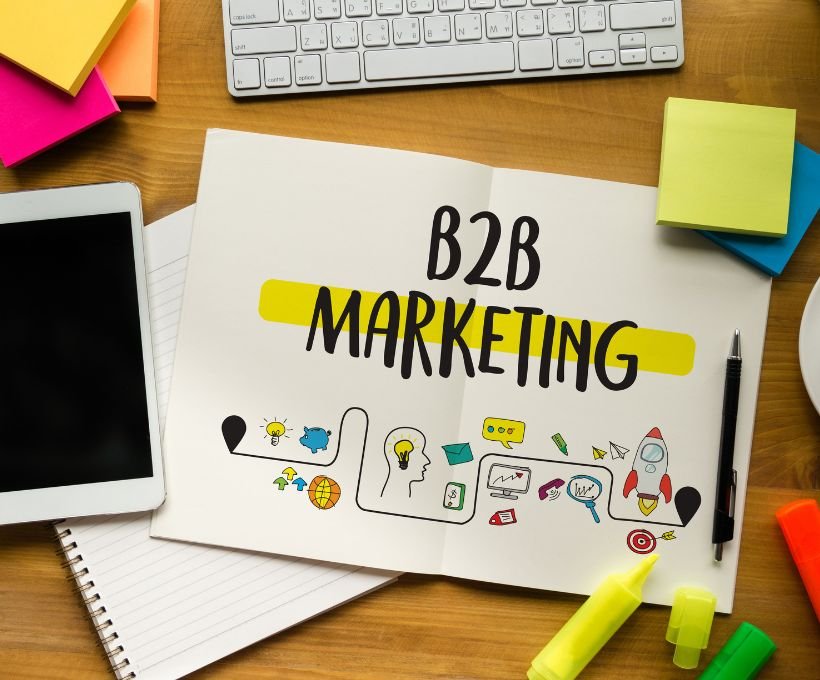Introduction
Hey there, hustlers! Let’s talk about the evolution of B2B marketing. It’s not just about selling products or services to businesses anymore. It’s about creating experiences, building relationships, and providing value that goes beyond the transactional. It’s about understanding that every business is a unique entity with its own set of challenges and needs. And guess what? The game is changing faster than ever.
In 2023, we’re not just surviving; we’re thriving in the B2B marketing space. We’re not just talking about incremental growth here. We’re talking about explosive, dynamic, hold-onto-your-hats kind of revenue growth. And how do we achieve that? By understanding the importance of revenue growth in B2B marketing.
Revenue growth isn’t just a nice-to-have; it’s a must-have. It’s the lifeblood of any business. It’s what allows you to invest in new products, hire more talent, and expand into new markets. But here’s the kicker: revenue growth doesn’t happen by accident. It’s the result of strategic, intentional, and focused efforts. It’s about understanding the market, knowing your customers, and delivering value at every stage of the customer journey.
The 2023 Blueprint for B2B Marketing
So, how do you navigate the ever-changing landscape of B2B marketing? You need a blueprint—a guide that can help you understand the terrain and plot a course towards success. And that’s exactly what we’re going to talk about: the 2023 Blueprint for B2B Marketing.
Understanding this blueprint is like having a map in the wilderness. It shows you where you are, where you need to go, and the best route to get there. It’s about understanding the key trends shaping the B2B marketing space, the strategies that are delivering results, and the tactics that can help you connect with your customers on a deeper level.
But here’s the thing: this isn’t a one-size-fits-all kind of deal. Every business is unique, and what works for one might not work for another. That’s why it’s crucial to understand the role of sales enablement in B2B marketing.
Sales enablement isn’t just a buzzword; it’s a game-changer. It’s about equipping your sales team with the tools, resources, and knowledge they need to succeed. It’s about breaking down silos between sales and marketing and fostering a culture of collaboration and shared success. It’s about understanding that your sales team isn’t just selling a product or service—they’re selling a solution to a problem, a path to a better future.
For instance, let’s take a look at a company like Slack. They’re not just selling a communication tool. They’re selling a solution to the problem of disconnected teams and inefficient workflows. They’re selling a path to a future where collaboration is seamless, and productivity is through the roof. And they do this by equipping their sales team with in-depth knowledge about their customers’ challenges and how their product can help overcome them. That’s sales enablement in action.
Stay tuned for more insights as we dive deeper into the key strategies for B2B marketing, the role of consultative prospecting, and how to navigate the sales process. We’re just getting started, and trust me, you won’t want to miss what’s coming next.
Key Strategies for B2B Marketing
Alright, let’s get down to the nitty-gritty. What are the key strategies that are going to drive your B2B marketing success in 2023? Let’s break it down:
- Value Creation Strategies: This is the heart and soul of B2B marketing. It’s not enough to just sell a product or service; you need to create tangible, measurable value for your customers. This could be anything from helping them streamline their operations, to reducing costs, to driving innovation. The key here is to understand your customers’ needs and challenges, and then position your product or service as the solution. For example, let’s take a look at Salesforce. They’re not just selling a CRM platform; they’re selling a way for businesses to better manage their customer relationships, streamline their sales processes, and ultimately drive more revenue. That’s value creation in action.
- Information Disparity: In the world of B2B marketing, knowledge is power. The more you know about your customers, the market, and your competition, the better positioned you are to succeed. But here’s the kicker: it’s not just about having information; it’s about having better information. This is where information disparity comes into play. It’s about knowing more than your customers and using that knowledge to guide them towards the best possible solution. It’s about being a trusted advisor, not just a vendor.
- Building Insights: This is where the rubber meets the road. It’s about taking all the information you have and turning it into actionable insights. It’s about understanding the trends, spotting the opportunities, and making the right decisions at the right time. But remember, insights are only as good as the actions they drive. So, don’t just gather information for the sake of it. Use it to drive your strategy, inform your decisions, and deliver better results for your customers.
The Role of Consultative Prospecting
Now, let’s talk about consultative prospecting. This isn’t your grandpa’s cold calling. This is about building relationships, understanding needs, and providing value from the very first interaction. It’s about cutting through the noise and connecting with your customers on a deeper level.
Here’s how it works:
- Understanding Your Customers: This is where it all starts. You need to understand who your customers are, what they need, and how you can help. This isn’t just about demographics; it’s about psychographics. It’s about understanding their challenges, their goals, and their motivations.
- Providing Value: Once you understand your customers, you need to provide value. This could be anything from sharing a relevant piece of content, to providing a useful insight, to offering a solution to a problem. The key here is to provide value before you ask for anything in return.
- Building Relationships: Consultative prospecting is all about building relationships. It’s about establishing trust, demonstrating credibility, and showing your customers that you’re not just interested in making a sale; you’re interested in helping them succeed.
- Differentiating and Winning the First Meeting: This is the end goal of consultative prospecting. It’s about standing out from the competition, winning the first meeting, and setting the stage for a successful sales process.
Remember, consultative prospecting isn’t a one-and-done deal. It’s a continuous process that requires ongoing effort, dedication, and refinement. But when done right, it can be a game-changer for your B2B marketing efforts.
Navigating the Sales Process
Alright, let’s keep the momentum going. You’ve built the relationships, you’ve provided the value, and you’ve won the first meeting. Now, it’s time to navigate the sales process. This is where things can get tricky, but don’t worry, I’ve got you covered. Let’s break it down:
- Gaining Commitments: The sales process isn’t a one-way street; it’s a two-way dialogue. It’s about gaining commitments from your customers at every stage of the journey. This could be a commitment to a follow-up meeting, a commitment to share information, or a commitment to make a decision. The key here is to be clear, direct, and respectful. Don’t be afraid to ask for what you need, but always do it in a way that respects your customer’s time, needs, and priorities.
- Addressing Objections and Concerns: Let’s be real, objections are a part of the sales process. But here’s the thing: objections aren’t roadblocks; they’re opportunities. They’re opportunities to address concerns, provide more information, and reinforce the value of your solution. So, don’t shy away from objections. Embrace them, address them head-on, and use them as an opportunity to deepen your relationship with your customers.
- The Importance of Advanced Discovery: Discovery isn’t just a stage in the sales process; it’s a continuous process that happens throughout the sales journey. It’s about constantly learning more about your customers, their needs, and their challenges. But remember, discovery isn’t just about asking questions; it’s about listening to the answers. It’s about understanding, empathizing, and using that information to provide a better, more tailored solution.
Differentiation and Consensus Building
Now, let’s talk about differentiation and consensus building. In a crowded market, differentiation is key. It’s about standing out from the competition and showing your customers why you’re the best choice. But differentiation isn’t just about being different; it’s about being better. It’s about delivering more value, providing better service, and offering a better customer experience.
Here’s how you can differentiate yourself in the B2B marketing space:
- Professional Differentiation: This is about being the best at what you do. It’s about having the best product, the best service, and the best team. But remember, professional differentiation isn’t just about being the best; it’s about being recognized as the best. So, don’t be shy about showcasing your achievements, sharing your success stories, and promoting your value.
- Consensus Building: In the B2B world, buying decisions are rarely made by one person. They’re made by a team of people, each with their own needs, priorities, and concerns. That’s why consensus building is so important. It’s about getting everyone on the same page and moving towards a common goal. Consensus building isn’t about convincing or coercing; it’s about collaborating. It’s about understanding each stakeholder’s needs, addressing their concerns, and showing them how your solution can help them achieve their goals.
Remember, differentiation and consensus building aren’t one-time efforts; they’re ongoing processes that require continuous effort, dedication, and refinement. But when done right, they can be a game-changer for your B2B marketing efforts.
Presentations, Proposals, and Negotiations
Alright, let’s bring it home. You’ve navigated the sales process, you’ve differentiated yourself, and you’ve built consensus. Now, it’s time to seal the deal with effective presentations, proposals, and negotiations.
- Crafting Effective Presentations and Proposals: This isn’t about dazzling your customers with flashy slides or complex jargon. It’s about clearly and effectively communicating the value of your solution. It’s about showing your customers how your product or service can help them overcome their challenges and achieve their goals. Remember, your presentation or proposal isn’t just a sales tool; it’s a communication tool. It’s an opportunity to reinforce your value, address any remaining concerns, and make a compelling case for your solution.
- Mastering Negotiations in B2B Sales: Negotiation is a natural part of the sales process. But here’s the thing: negotiation isn’t about winning or losing; it’s about finding a solution that benefits both parties. So, don’t approach negotiations as a battle to be won. Approach them as an opportunity to collaborate, compromise, and find a solution that delivers value for both you and your customer.
Conclusion
So, there you have it. The 2023 Blueprint for B2B Marketing. It’s not just about selling products or services; it’s about creating value, building relationships, and driving revenue growth. It’s about understanding your customers, differentiating yourself, and navigating the sales process with skill and confidence.
But remember, this isn’t a one-and-done deal. It’s a continuous journey that requires ongoing effort, dedication, and refinement. But when done right, it can be a game-changer for your B2B marketing efforts. So, let’s get out there and make it happen. Let’s revolutionize B2B marketing and drive the kind of revenue growth that makes the competition green with envy.


